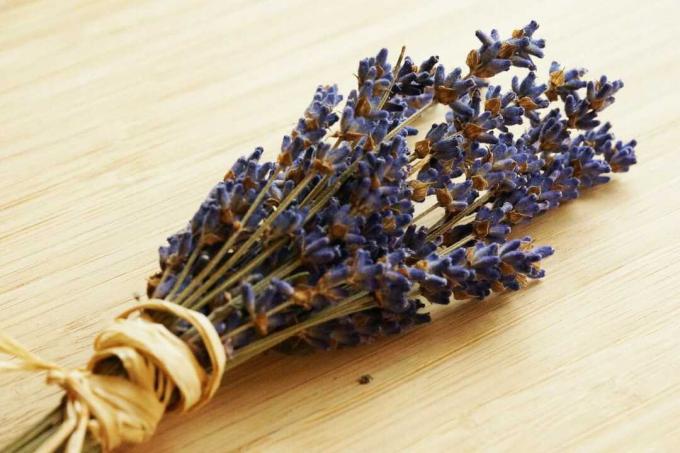
table of contents
- Why in summer?
- The right time
- Tools
- Instructions for cutting
- frequently asked Questions
Regular pruning measures are essential so that lavender develops well and blooms profusely in the home garden. A pruning promotes growth and blossom. How to properly perform the summer pruning on the lavender.
In a nutshell
- Pruning ensures compact growth and abundance of flowers
- Summer cut one of a total of two cuts per year
- shouldn't be done too late in the year
- is mainly used for care and harvest
Why in summer?
The so-called summer cut is usually a light shape and care cut of the lavender. It keeps the plants in shape and supports plant health. Lavender belongs to the semi-woody species, i.e. H. he lignified and balds with age. If it is not cut regularly, the lignification will continue. The shrub grows old, sparsely growing, the willingness to flower decreases more and more until finally only the shoot tips are green. This can only be prevented with the right cut at the right time.
The right time
When the flowering is nearing its end, lavender should be cut just before all the small flowers on the spike-shaped panicles faded are. Depending on the weather, this is the case in late summer around the end of July. A rule of thumb is that lavender needs to be cut two weeks after the first flowers have formed. The flowering time and thus also the exact time of cutting can vary slightly between the individual varieties.

However, all pruning measures should be completed by the end of August at the latest, even for late-blooming varieties. A later cut would have a negative impact on the frost resistance of the plants. After cutting, they form new shoots, which in turn would not have enough time to mature before the first frost and could freeze to death. A summer pruning at the right time prevents the lavender from investing its energy in the formation of seeds and thus stimulates it to a second bloom.
Tip: If the right time has been missed, it is advisable to wait until next spring. Cutting back in autumn is not recommended.
Tools
With the right tool, major damage to the plants can be prevented. The most important thing is a sufficiently sharp pair of secateurs. A large part of these subshrubs can be processed very well with it. If the lavender is already lignified or its shoots are a bit stronger, hedge trimmers or small handsaws are a good choice. To make the cut easier in general, the secateurs should always be placed at a slight angle and over a leaf knot. A slightly oblique cut can prevent the shoots from being crushed.
Tip: It is generally advisable to thoroughly sharpen and clean all cutting tools before and, if possible, after the cut, and even to disinfect them at best.
Instructions for cutting
Care cut
While in spring it is normally possible to cut back more, by up to two thirds, in summer the cut is a little more restrained. Here you cut about a third. There are also differences between young and older shrubs.

- Always cut back young shrubs a little more
- up to a maximum of half
- promotes more compact growth
- Cut older plants less severely
- often have strongly lignified shoots
- in the first step after flowering, remove withered inflorescences
- then cut the entire plant into a bushy shape
- Shorten the stalk about ten centimeters deep
- best time of day for pruning measures early in the morning
- seal larger interfaces after cutting
- for example with tree wax or wood tar
On the one hand, the sealing should prevent the penetration of germs and pathogens and, on the other hand, accelerate the healing process. In general, when cutting lavender in summer, care should be taken not to cut too deeply into the old wood, as there is usually no new shoot there. In addition, you should leave some of the young shoots and always a short piece of last year's shoots including leaves on the plants. Sometimes the cut is too high. This is possible, but has no maintenance effect.
Tip: Regular pruning of tall lavender stems is particularly important. The shoots are shortened to a uniform length so that the crown remains dense and in shape.
For harvest
The cut in summer can also be done for the purpose of harvesting. It is cut when some of the flowers are still closed, i.e. a little earlier than with the maintenance cut. This cut should also only be in the herbaceous area. To harvest the flowers, it is advisable to remove about ten centimeters from the branches. Ideally, you cut the entire plant and tie the branches together to dry in small bunches.

frequently asked Questions
Opinions differ when it comes to the best time to rejuvenate. Some recommend spring for this, others have had good experiences in summer when the normal summer pruning is carried out. These bushes have just sprouted afterwards and bloomed in the following spring.
Yes, because young lavender should only be cut in summer in the first year and not in spring.
With regular, professional pruning and appropriate care, both in summer and in spring, these plants can be at least 10 and a maximum of 30 years old.
